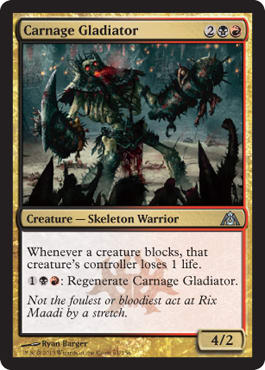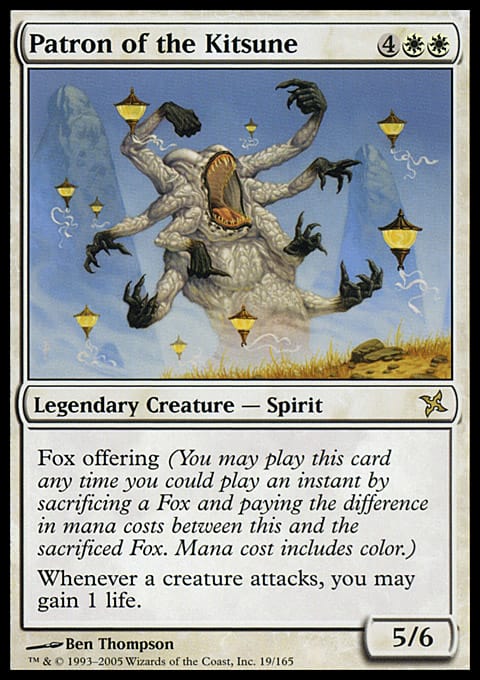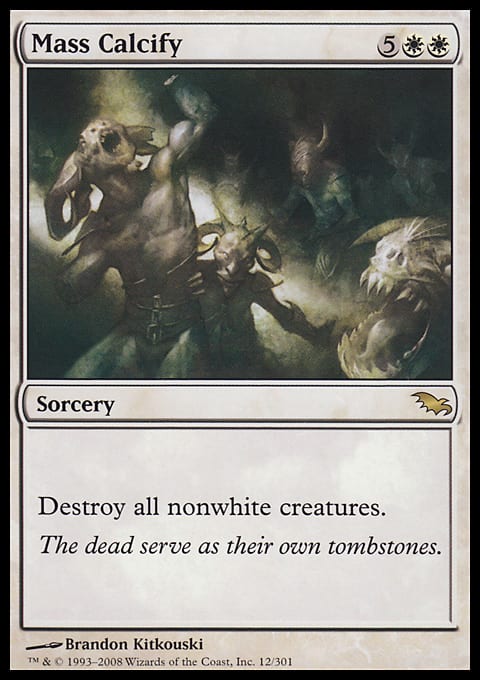When you look at a card to see what is valuable for your next deck, how do you evaluate the card? What do you look for? And more importantly, are you able to tune out the white noise in order to practically evaluate the card?
I want you to take a look at the following card with me. Consider its value in multiplayer; here we go:
It has two abilities. It can regenerate for 3 mana, and whenever a creature blocks, that controller loses a life. That means when you block, when Harry blocks, and when Sally blocks, they all take damage. Even if you block my big Dragon with your little Fog of Gnats and regenerate it, you still lose a life. The Gladiator impacts every creature around the board.
What sort of decks does a regenerating, 4/2, 4-mana creature that can zark players when they defend go into? It can swing offensively for life-loss and then regenerate it to keep it alive. Or it can hold back and keep on the defense while others lose life as they block over the course of a game. It has a lot of value. Sure, Carnage Gladiator may not be the next Commander all-star, but it can ball.
Now that you have seen how to evaluate the nature of a card for multiplayer, I want you to look at another card. Check out . . .
Take a look at it. Read what Fox offering does. Now review its abilities and come back. You gain a life anytime a creature attacks. And it has Fox offering. Here is what a lot of players have done over the years: They have looked at this card, seen the Fox offering ability, and then just looked past the card. What sort of deck would you play this card in? Obviously a Kitsune deck. Do I have one? Nope? Time to move on.
But wait a second. The reason I started by having you consider Carnage Gladiator was that I wanted to put you in the mindset of looking at Patron of the Kitsune in a different light. It costs 6 mana, and you receive a serviceable 5/6 body. Then, you gain this ability: “Whenever a creature attacks, gain 1 life.” Note some words that are missing from that ability, such as “your” or “you.” Does it say, “Whenever a creature attacks you, gain 1 life?” Nope. What about, “Whenever your creature attacks, gain 1 life?” Not that either. Whenever any creature attacks any player or planeswalker, you will gain life. Is there a lot of attacking in your multiplayer game? Then Patron of the Kitsune is an absolute house!
That’s where today’s issue comes from. The Fox Offering Syndrome. I extolled the Patron in several articles through the years, and a lot of people told me that they had never looked at the card in that light. They had just internally assessed it as a tribal card for a Fox or Kitsune deck and mentally moved past it.
The syndrome occurs when you see some abilities on cards that are not the important part and then glide over the rest. We are all guilty of it (including me). Sometimes, I think a card would be played more often without some abilities. We understand simplicity. Patron of the Kitsune minus the Fox offering would see more play around the kitchen table.
What are some other cards that are obvious Fox Offering Syndrome candidates? One has to be Wrexial, the Risen Deep. Usually when we see landwalk abilities, we begin to drop a creature’s overall review in our heads. After all, it can only be unblockable sometimes. Compare Bog Wraith to Covert Operative. Even with a cheaper cost and a bigger butt, we would almost always want the Covert Op if we had to choose one for our next U/B deck. Wrexial has an amazing ability that triggers when he hits. But my mental assessment of Wrexial’s potential is often diminished by my assessment of landwalking.
Imagine Wrexial without landwalking of any sort. Now, after looking at how great it is, add the ’walking back to the card, and you have a real hit on your hands! Cards like Wrexial and Patron of the Kitsune don’t suck.
One Fox Offering Syndrome card I have to admit I missed on was Mass Calcify. You pay 7 mana to destroy all nonwhite dudes at the table. What sort of deck does Mass Calcify want to be in? Mono-white, right? The first thing I did when I saw this card was imagine all of the creatures it would not kill, such as Akroma, Angel of Wrath, Stonehewer Giant, and Yosei, the Morning Star. Because it wouldn’t kill roughly twenty percent of the creatures in Magic (the gold creatures make it slightly more than one-fifth of all creatures, but the colorless artifact creatures drop it again, so I think they roughly counter each other), I dismissed it as a mass-removal card.
Then, I began playing with it, and you know what? It was amazing! It was so good because I forgot to include in my list of creatures that it will not kill these creatures: all of mine. It’s like a 7-mana Plague Wind that leaves behind a small remnant of creatures. I added it to my two-colored decks and was still impressed. I liked keeping back half my guys and seeing whole boards wiped out, with maybe one or two people still having one or two creatures.
Mass Calcify does not suck—in a mono-white deck, barring artifact creatures, it will keep alive one hundred percent of the bodies you are playing versus twenty percent of those your foes have. And that’s good math.
Let’s add Mass Calcify to the list of Fox Offering Syndrome contenders. What other cards are out there?
How about Fight to the Death? What? Exactly! Take a look at this powerful instant.
You destroy all blocking and blocked creatures. It’s that simple. Now, in a duel, you could use this to destroy those powerful attackers that you chump-blocked or those potent blockers you suicidally attacked into. That’s decent enough. But in multiplayer? Hoo boy! This is really upgraded in value. When Harry attacks Sally, just use this to blow up a lot of stuff. Sometimes, you will clear out a whole board, and other times, you kill three or four crucial creatures. But it’s usually a potent smash to the face when you play it.
We often assess Fight to the Death as if we were in a duel, and there, it will probably be card disadvantage because I am losing my creatures as well. But when I have multiple foes, it can rip apart one’s offense and another’s defense in one spell. You’ll often kill stuff that attacks or blocks with impunity, such as Commander Eesha, Akroma the Envigilanced, and more. It breaks open that which was closed.
What Fight to the Death reveals is that we often Fox Offering ourselves, not by a line of text that seems to prejudge our views of the card, but instead by how it reacts in one environment, thus biasing our view of how it will react in others. The card that is bad in duels can be much better in multiplayer simply because of how numbers shift. Be aware of these syndrome cards. We don’t want our old assumptions to remain about cards that are empowered in a new environment.
Patron of the Kitsune is clearly obfuscated by the fact that it is a tribal card. Sure, it may be really powerful outside its tribe, but it is still a tribal card in our heads. Other examples include other tribal cards, such as Patron of the Nezumi, Corpse Harvester, Riptide Laboratory, and Call to the Grave. These are great examples of cards that suffer from the Fox Offering Syndrome.
We also do this with colors. Take Evolution Vat as an example. It can tap a creature and toss a +1/+1 counter on it. If we have some mana, we can spend it to double the counters on the creature (and if we tap someone else’s creature, he or she can do the same). Because it becomes better in a deck with access to both green and blue mana, we often put it into the Simic category in our head. We don’t pull it out unless we have a Simic deck that wants counters.
Yet, it works in other decks, too. You can put it alongside Dragon Blood in a deck that wants to put a +1/+1 counter on a creature that just came back with a -1/-1 counter from persist. Or we can add a counter to Triskelion or Spike Weaver or it can have doubled by a card like Corpsejack Menace. And you can tap a creature with it, unlike other counter-adding cards, so you can play defense when needed. So, Evolution Vat has a lot of uses, and it doesn’t require the G/U combination to work. It is another card that has been Fox Offering’d.
The point of today’s article is to demonstrate that there are a significant number of cards out there that we have prejudged and found not worthy of play for a variety of reasons that have nothing to do with the actual cards. We fail to assess proper power in the format of choice because of language that interferes with how it should be seen. We allow noise to break us from truly seeing the cards. Perhaps we fail to assess value because of how some cards work in other formats. When we see how a card is not in a perfect situation in a tribal deck or cannot kill everything or using the perfect color combination, we fail to see how good it can still be in our decks and in our games. Maybe it’s not the pitch-perfect sunburst or Kitsune deck, but it is good enough to work. It’s good enough to win.
So, make sure that you properly evaluate cards the next time you look at them, and try to remember the Fox Offering Syndrome.
See you next week,
Abe Sargent

























